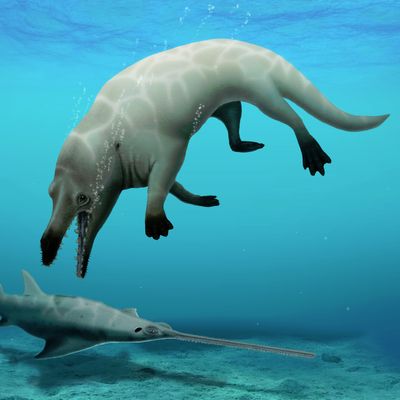
One nice thing about whales — and there are many, too many to count — is that they are always surprising us. You thought the Cuvier’s beaked whale could only hold its breath for, like, 30 minutes? Try almost four hours, bitch. You thought a pod of frisky beluga boys wouldn’t invite a narwhal to join in their “social, sexual games”? Guess again, lads; they would, and they did. You thought whales couldn’t have four legs and the dumb hapless look of a Labrador crossed with a platypus? Wow, wrong again!
Scientists have now discovered the 43-million-year-old remains of a freaky old whale in Egypt’s Western Desert, the fossils of a roughly ten-foot amphibious specimen that conquered both land and sea with its funny paddle feet. They are calling it the Phiomicetus anubis, in deference to Anubis, the jackal-headed god in charge of weighing the hearts of dead kings against feathers and chaperoning their souls to the afterlife. According to a paper published in Proceedings of the Royal Society B, the whale’s “unusual” bottleneck-looking jaw suggests a “strong raptorial feeding style.” It likely represents a midpoint in modern whales’ transition from “herbivorous, deer-like, terrestrial mammals into carnivorous and fully aquatic cetaceans.” The study’s lead author, Abdullah Gohar of the Mansoura University vertebrate paleontology center, called this a “a key new whale species,” and frankly: Yes.
But maybe you are wondering: How was I supposed to know that whales could walk around on their four legs if they have long since evolved away from that behavior, and this discovery is new? Please, cast your mind back to 2019, when a team of paleontologists digging around in Peru found the skeletal bits of a comparably old four-legged whale, which also looked like a weird dog-eel. Land-capable whales had, at the time, already been disinterred in India and Pakistan, not to steal the Peruvian leviathan’s thunder or anything. “Whales are this iconic example of evolution. They went from small hoofed mammals to the blue whale we have today,” Travis Park, an ancient whale researcher at the Natural History Museum in London, marveled to the BBC. “It’s so interesting to see how they conquered the oceans.”
True icons, and yet we continue to underestimate them, assuming they could never have legs.





